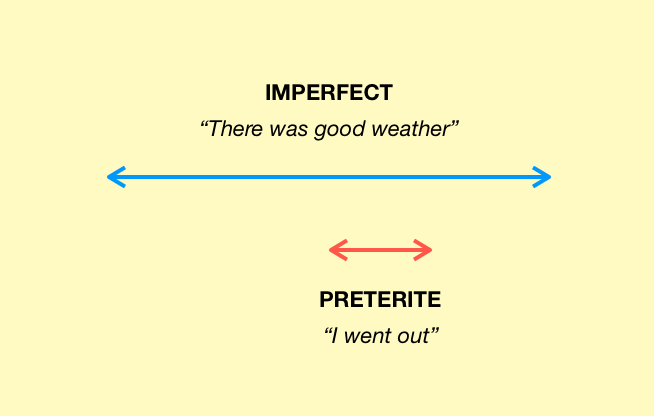Welcome 😊 to our grammar lesson on the topic of Preterite Vs. Imperfect in Spanish. Choosing between these 2 past tenses is usually a challenge for Spanish learners.
In this lesson you will learn to choose between them, and to mix them sentences and paragraphs. We will practice the topic with several exercises.

For clarity, we will associate the color orange with Preterite, and green with Imperfect.
Note: We also have a separate lesson for each tense, where we explain their conjugations and provide more examples:
Contents
Preterite vs Imperfect – The difference
We use both Preterite and Imperfect to talk about the past, but in different ways.
In general…
- The Preterite is the tense for main actions. It answers the question: “What happened?”.
- The Imperfect is the tense for background information. It answers the question: “What was going on?”.
So basically the Imperfect sets the stage for the action, and the Preterite narrates the action.
Let’s study the uses of each tense separately.
Uses of the Preterite
As we said, the Preterite is the tense for main actions. It answers the question: “What happened?”. That’s the basic idea.
Also, there are some specific cases where we always choose the Preterite over the Imperfect. For example:
- actions that happened a stated number of times
- actions with a stated duration
- a chain of events, one after another
- verbs for beginnings and endings (“empezar, terminar…”), tend to be in Preterite and not Imperfect.
Examples:
Juan compró una lavadora ayer.
Juan bought a washing machine yesterday. (this answers the question “What happened?”)
El año pasado estuve enfermo dos veces.
Last year I was sick twice. (number of times is stated, so we can confidently choose the Preterite)Viví diez años en Perú.
I lived in Peru for ten years. (duration is stated, so we can confidently choose the Preterite)Ayer, Laura se levantó a las siete de la mañana. Luego se duchó, desayunó, se vistió y fue a hacer la compra.
Yesterday, Laura got up at seven in the morning. Then she took a shower, ate breakfast, got dressed, and went shopping. (a chain of events one after another, so we can confidently choose the Preterite)La película empezó a las diez.
The movie started at ten o’clock. (expresses a beginning or ending, so it is likely in Preterite and not Imperfect)
Uses of the Imperfect
The Imperfect is the tense for background information. It answers the question: “What was going on?”.
Typical cases where we use it are:
- descriptions of people (physical or psychological), things and places
- ongoing situations and habitual actions in the past (without stating an exact number of times)
- time frames: date, time, age…
Examples:
Nuestra casa era grande y tenía tres plantas.
Our house was big and had three floors. (description)Cuando yo era niño, mi padre trabajaba en una fábrica. Todos los días volvía tarde a casa.
When I was a child, my father worked in a factory. Every day he would come home late. (ongoing situation, habitual actions without stating an exact number of times)Era el año 2005 cuando…
It was 2005 when… (time frame: date)Cuando yo tenía 20 años…
When I was 20 years old… (time frame: age)
Preterite and Imperfect in the same sentence
If a sentence expresses 2 actions that happened at the same time, but one took longer than the other, the longer action tends to be in Imperfect, because it is considered “background information”. The shorter action tends to be in Preterite.
We can understand it better with the following graph:

Examples:
Ayer hacía buen tiempo y por eso salí.
Yesterday there was good weather, so I went out.El otro día, vi a una mujer que jugaba con su hijo.
The other day, I saw a woman who was playing with her son.
Practice
Now that we know the theory, let’s practice choosing between the Spanish Preterite and the Imperfect with some exercises.
Exercise 1: Choose Preterite or Imperfect
In the following sentences, try to guess if the verb should be in Preterite (orange) or Imperfect (green).
Click on the grey spaces to see the solutions, and then read the analysis where we explain the reason for every choice.
1) Yo fui al parque ayer.
I went to the park yesterday.
2) Los españoles descubrieron América en 1492.
The Spaniards discovered America in 1492.
3) De niño, jugaba a videojuegos todos los días.
As a kid, I used to play video games every day.
4) Mi abuelo era siempre divertido.
My grandfather was always fun.
5) Nosotros comimos y luego fuimos a la playa.
We ate and then went to the beach.
6) Él vivió primero en Dinamarca y después en España.
First he lived in Denmark and then in Spain.
7) Tú trabajaste 25 años en la compañía.
You worked at the company for 25 years.
8) Ella se casó dos veces.
She married twice.
Analysis of each sentence
1) This sentence simply expresses what happened ➡ Preterite
2) Again, something happened ➡ Preterite
3) Habitual action without stating an exact number of times ➡ Imperfect
4) Description of a person ➡ Imperfect
5) A chain of events, one after another ➡ both verbs in Preterite
6) Another chain of events. Each event might have taken years, but the sentence is still a chain of events one after another ➡ Preterite
7) Stated duration, so here we can be very confident ➡ Preterite.
8) Stated number of times, so again very confidently we choose… ➡ Preterite
Exercise 2: Preterite and Imperfect in the same sentence
Each of these sentences includes two verbs, one in Preterite and one in Imperfect. Try to guess the tenses, then read our analysis:
1) Yo paseaba por el parque cuando vi a mis amigos.
I was walking in the park when I saw my friends.
2) Compré un reloj porque lo necesitaba.
I bought a watch because I needed it.
3) Cuando estábamos en la playa, vimos a Roberto.
When we were on the beach, we saw Roberto.
4) ¿Notaste que la habitación estaba vacía?
Did you notice the room was empty?
5) Conocí a un hombre que vivía en la jungla.
I met a man who was living in the jungle.
Analysis
1) “Walking in the park” and “seeing my friends” both happened at the same time. But walking took longer, so we consider it background information. In other words: What was going on? I was walking. What happened? I saw my friends. ➡ was walking = Imperfect, saw = Preterite
2) “Buying the watch” and “needing it” both happened at the same time. But needing it took longer, so we consider it background information. ➡ bought = Preterite, needed = Imperfect
3) “Being on the beach” took longer than “seeing Roberto” ➡ were = Imperfect, saw = Preterite
4) “The room being empty” is longer than “noticing it”. ➡ notice = Preterite, was = Imperfect
5) At this point, you don’t even need the explanation 😄 ➡ met = Preterite, was living = Imperfect
Exercise 3: A story
Finally, here is a paragraph that constantly mixes Preterite and Imperfect.
Try to guess the tenses and then read our analysis:
La princesa Isabel era (1) rubia y muy guapa. Vivía (2) en un gran castillo. Pero tenía (3) 25 años y aún no tenía (4) un esposo. Un día, un príncipe llegó (5) desde un reino lejano. Era (6) un poco feo, pero también simpático y divertido. Invitó (7) a la princesa a pasar el día con él, y ella aceptó (8). Montaron (9) a caballo, navegaron (10) por un lago y se hicieron (11) regalos. Por la noche, mientras miraban (12) las estrellas, él le preguntó (13) si quería (14) casarse con él. La princesa dijo (15) que no, y el príncipe regresó (16) a su reino.
Princess Isabel was (1) blonde and very pretty. She lived (2) in a big castle. But she was (3) 25 years old and still didn’t have (4) a husband. One day a prince arrived (5) from a faraway kingdom. He was (6) a bit ugly, but also nice and funny. He invited (7) the princess to spend the day with him, and she accepted (8). They rode (9) horses, sailed (10) on a lake and gave (11) each other presents. At night, as they were looking (12) at the stars, he asked (13) her if she wanted (14) to marry him. The princess said (15) no and the prince returned (16) to his kingdom.
Analysis
1) Description of her looks ➡ Imperfect
2) Ongoing situation in the past, background information: where she was living when the story begins ➡ Imperfect
3) Time frame: age ➡ Imperfect
4) More background info, what was going on in her life: she didn’t have a husband ➡ Imperfect
5) A prince arrived. A main action that happened ➡ Preterite
6) Description of his looks 😄 ➡ Imperfect
7, 8, 9, 10 and 11) A chain of events, one after another ➡ Preterite
12) Background info for other actions. It takes place at the same time, but is longer than those other actions ➡ Imperfect
13 and 14) This one is a bit tricky. If we consider these two actions, him asking is the shorter one. Her wanting (or not wanting) is, in comparison, longer: her feelings about him at the time ➡ 13 is Preterite and 14 is Imperfect.
15 and 16) A chain of events one after another ➡ Preterite








